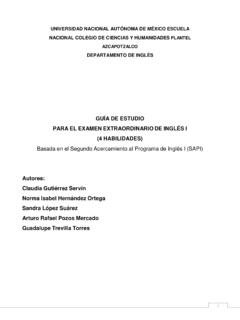Transcription of Spanish Pronunciation: The Complete Guide
1 pronunciation : The Complete GuideOne of the big mistakes made by many Spanish students is spending all of their time and effort learning vocabularyand grammar while neglecting Spanish pronunciation . This is big mistake for those who aspire to do more than readand write in Spanish , since your ability to use effective pronunciation will have a much greater impact on your ability tobe understood by native Spanish speakers than occasional grammar I [spoke to someone], they kept asking me What? What? I would repeat mysentence again and again.
2 Finally they would say Ah-ha! and then repeat my sentence, usingexactly my words! It was very humiliating. I knew my words and grammar were good, butnobody would understand me, just because of my other mistake that Spanish students often make is to delay the study of pronunciation until after they havealready acquired a large vocabulary. This is also a big mistake learning vocabulary without correct pronunciationfrom the beginning means that you end up building a large vocabulary of words that you can recognize one paper, butcannot faithfully reproduce orally.
3 These words must later be re-learned a second time with proper pronunciation an increasingly difficult task when you have been pronouncing words incorrectly for a long time. For this reason,proper pronunciation should be stressed from the very beginning of your language study in order to provide a solidfoundation for future to use this GuideThe primary goal of this Guide is to teach you how to first hear, and eventually replicate, proper Spanishpronunciation. Each section below contains audio exercises designed to help you to practice specific aspects ofSpanish pronunciation .
4 Simply reading through this Guide without taking the time to Complete the audioexercises will likely do little to improve your pronunciation in Spanish . Listen to the audio exercises carefullyand try to emulate their pronunciation as closely as possible. Practice the audio exercises over and over until you areconfident you are pronouncing the words correctly. (You can use the link below to download the audio files to yourcomputer for additional practice.)Download Complete Guide and Audio Files: Click here to download a PDF copy of this Guide along with all of theaudio files to your of ContentsThe phonetic system in SpanishPronunciation of the Spanish alphabetPronunciation of Spanish vowelsStress placement in SpanishPronunciation of Spanish consonantsSpanish intonationReferencesThe phonetic system in SpanishThe good news for learning Spanish pronunciation is that the Spanish language is almost perfectly phonetic.
5 Meaning there is a consistent relationship between the way a word is spelled and the way it sounds: You can look atalmost any written word in Spanish and automatically know how to pronounce it. This makes mastering Spanishpronunciation considerably easier than English, where the pronunciation of words must be learnedindependently from their written form. Consider, for example, the different pronunciations of the ough suffix in thefollowing English words:1. though (like o in go)2. through (like oo in too)3. cough (like off in offer)4.
6 Rough (like uff in suffer)5. plough (like ow in flower)6. ought (like aw in saw)In English it is almost impossible to determine the correct pronunciation of a word based on spelling alone. However, Spanish letters and letter combinations are almost always pronounced the same way. This makes Spanishpronunciation relatively simple to replicate once you master some the basic rules and a few the unique errors from English vowel influence in similar-sounding wordsAs an initial exercise, it is useful to examine the difference in pronunciation of certain Spanish words that are similar inform to words in English.
7 Consider the list below. Although these words may seem familiar, their Spanishpronunciation is quite different, and you are liable to make serious mistakes if you attempt to pronounce them in theEnglish-sounding way. Note that in the list below we have placed an accent mark ( ) to indicate a stressed vowel,even though this does not occur in normal Spanish spelling of these words. Also note that the English words given arenot always translations of the Spanish ; they are simply used to represent the English word the Spanish word mightremind you Exercise.
8 English-sounding wordsofic naofficedoct rdoctoroportunid dopportunitycongr socongressconfer nciaconferencetropic ltropicalat micaatomicHond rasHondurasconversaci nconversationhospit lhospitalcontr tocontractpos blepossiblebombard obombardmentpr ntoprontopr ximaapproximatef sforophosphorusc stocostbl ncablankK nsasKansasp sepasscl seclassgr ciasgrassl stimalastesp olspanielabsol toabsolutePronunciation of the Spanish alphabetThe Spanish alphabet , or abecedario, is similar to the English alphabet , with the addition of a few letters that areunique to Spanish .
9 In later sections, we ll take a full examination of the range of sounds that each letter makes aspart of word. In this section we simply review the name of and pronunciation of each of the letters Exercise: The letters of the Spanish alphabetWatch the following video and repeat the name of each letter as : This video presents the traditional Spanish alphabet . You should be aware that in 2010, the official Spanishalphabet was changed by the Royal Spanish Academy. The letters Ch and Ll were removed, and the names of someother letters were clarified or changed: V becomes uve instead of ve, to avoid confusion with B (be) W becomes uve doble instead of doble ve.
10 Y becomes ye instead of i griega Although these differences are relatively minor, you should be aware of Key for Spanish LettersThe last exercise introduced you to the names of each of the letters in Spanish . The pronunciation Key belowdescribes the sounds that each individual letter makes as part of a word. We will cover the sounds of that each lettermakes in greater detail in the individual sections on Spanish vowels and Spanish consonants. For now, you shouldreview the pronunciation Key only to familiarize yourself with the basic pronunciation of each : This chart is only partially reproduced here.

